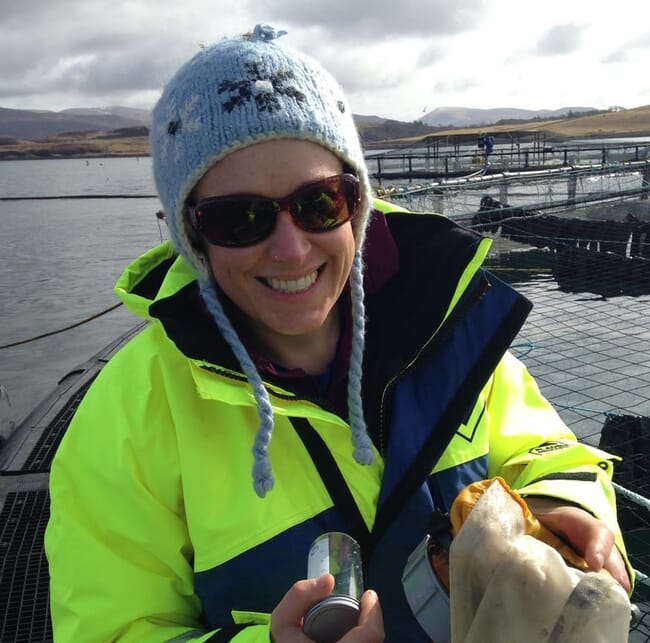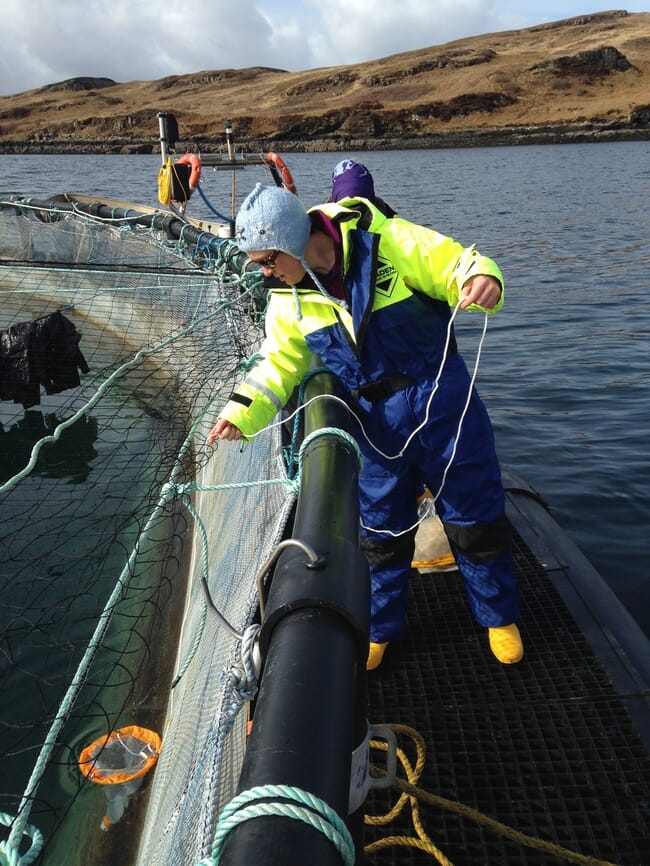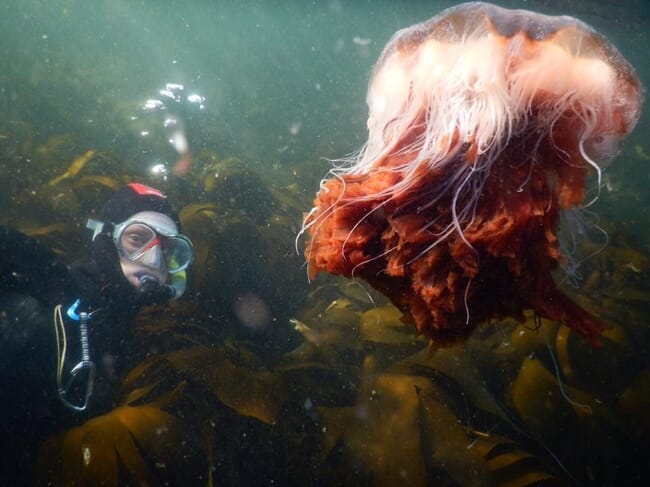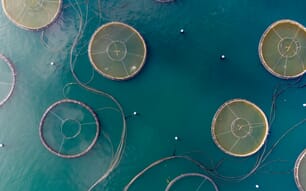Briefly describe your aquaculture career
I did a PhD in marine biology at the University of St Andrews, looking at how blooms of microscopic jellyfish can affect salmon aquaculture. Since then, I’ve consulted with various aquaculture companies and worked as the laboratory manager at a salmon health company.

What inspired you to start in aquaculture?
I started out being interested in jellyfish! I had some past experience researching box jellyfish in Australia before moving to Scotland. When I looked into doing a PhD, I began by working out how my expertise could be applied here. From there, I gained experience in salmon production and fish health, particularly in their sub-lethal interactions. Enormous blooms of large jellyfish that obliterate whole farms are rare, but smaller blooms of jellyfish, particularly those of microscopic size, can cause or contribute to disease processes and mortality on a relatively frequent basis.
Describe a typical day in your current role
It’s pretty varied. I might spend days in the lab measuring gill development in salmon smolts, out in the field collecting samples, or at my desk working on coordinating partnerships between university research and industrial production. One partnership that I’ve worked on in the past involved cooperating with specific farm sites to monitor their jellyfish blooms, and we’ve been making an effort to get that started again on a wider scale, hopefully with many farms making a quick check on a daily basis. With that kind of information pooled in a database, we could really make a dent in understanding harmful zooplankton dynamics.
What's the most unusual experience you've had in aquaculture?
During mackerel season in Shetland one year, there were huge schools around the salmon cages that would hit a line in seconds. I had to do some sample collection, but as I was working away at that, the site manager kept hauling in mackerel after mackerel after mackerel – and then gave me about fifteen of them, filleted. My friends and I ate rather a lot of mackerel that week!

How important are sustainability concerns to you and how do you address them in your work?
I try to make as many personal adjustments toward sustainability as I can, for example by assessing whether consultations can be best done remotely or in person, and trying to consolidate the travel I need to do. I also try to stay informed about green goals in the industry – for example, I'm looking forward to a time when salmon production is able to completely move way from using wild-caught pelagic fish. Generally, I have a lot of respect for salmon aquaculture as an industry willing to invest in ensuring its long-term future by researching and adopting practices that are good for both the environment and its bottom line, and I hope that that continues.
What new technical or product innovation do you think has the most potential to change aquaculture?
I’m excited to see the future of recirculating aquaculture systems (RAS). If RAS can meet the same level of demand as sea-cage farming does, with a similar environmental footprint, it would be a game changer in terms of avoiding many environmentally-driven production issues – like jellyfish!
On the other hand, I know there is a comparable amount of interest and planning for moving nearshore cages much further out to sea. That would probably change the game a lot in terms of what fish might be exposed to, and will require a lot of adjustments in the ways we presently deal with fish health.
Are there any individuals or organisations in aquaculture who you’ve found particularly inspirational?
Everyone I’ve ever worked with who makes hard work a great laugh! Some of my favourite people to meet are older or retired fish farm owners who got into the game 20 or 30 years ago, when you could have a singly-owned private farm, but who have since moved on to other roles in aquaculture. They always have great insights to share – about how things have improved but how – on occasion – an older, forgotten approach could solve a modern problem. I spent a lot of time on a boat with a chap named Kenny up in Shetland who had loads of tales about the old days - sometimes they were the bad old days and sometimes they were the good old days, depending on the story.

Have you faced any particular challenges as a woman in aquaculture?
I think aquaculture is growing to be a lot more gender-inclusive than some industries, but you still get the occasional bro-heavy site that has magazine clippings of porn on the walls or people who make sexist jokes. Even in just the few years I’ve been working in aquaculture, though, these sorts of practices seem to be on the out, maybe because there are more women working on sites. I hope that that trend continues.
How are women addressing inequalities in aquaculture in your region and have you seen the opportunities improve in recent years?
In my sector of aquaculture, a bridge between industry and academia, I think there is some capacity to plan research and projects around life requirements like maternity leave. I think that helps make sure that women who take time off are then able to come back instead of losing a career trajectory altogether. After maternity leave, the women I know who work in aquaculture and who have families seem to all have partners who share the childcare responsibilities. I think that, as in any industry, making sure that family and life obligations are split flexibly and equitably is a key aspect in reducing inequality.
What advice would you give to women looking to start a career in the aquaculture sector?
Try to make good contacts and relationships during your training. It really helps when people know you and what you can bring to the table.

What would be your dream role in aquaculture and do you think it’s realistic to achieve?
I’d love to oversee a marine biological division of a major aquaculture company, managing projects in both environmental conservation and fish health. I think there’s a strong overlap there, where people who have a good understanding of the health of the local environment can contribute quite a lot to understanding the health of the fish. There is scope for quite a few projects in that space that span the interests of both industry and academia, with beneficial outcomes for both.
What has been the industry’s greatest accomplishment in recent years?
In Scotland, I'd say probably the use of wrasse and lumpfish as sea lice control. Worldwide, polycultural aquaculture such as the use of fish in rice paddies or co-production of prawns and clams is a pretty big deal. Obviously polyculture makes things more complex in terms of management, but it’s great to see innovative ways of reducing pesticide use and overall environmental impact, and the amount of investment put into those strategies is heartening. I hope to see that trend continue, with some multi-trophic ideas being implemented in future.
What outstanding challenge would you most like to solve?
I’m obviously biased, but I’d suggest that harmful gelatinous zooplankton should be getting more attention. Complex gill disease has emerged as a real issue in salmon aquaculture, and I think a better understanding of stinging jellyfish population dynamics and interactions in that situation is a critical part of the solution going forward. In my opinion, this is something that gets neglected in favour of better known health issues. I’d like to see all sites adopt biological water quality sampling as part of their daily routine, with a centralised data input that would help us quantify and track the dynamics of harmful plankton.








